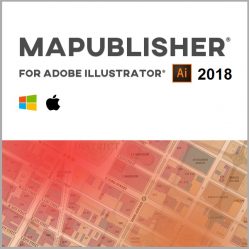

MAPublisher makes use of these by you creating StyleSheets. Illustrator uses Graphic Styles and Markers (former for lines and polygons, the latter for points). Just dragging a layer from one MapView to another will rescale, reproject and move the data as necessary to move it from one map to the other. MAPublisher allows you to have as many MapViews as you need so the entire document is like a MapInfo Layout, thus you could have a dozen separate maps on the page, each with its own MapView. It effectively has a layer control so you can move the layers up and down, switch them on or off, etc. It will also keep much of the MapInfo style as part of the import, though you will probably want to replace that.Īfter import everything ends up in a MapView which is equivalent to a Map Window in MapInfo. tab files from MapInfo (and lots of other things like.
#MAPUBLISHER PLUGIN FOR ILLUSTRATOR. PLUS#
Plus the nine other major plug-ins all designed to help the vector creative cause.XYZ are the UK & Ireland distributors for MAPublisher so I can tell you exactly how this will work.įirstly there is no need to export anything from MapInfo as MAPublisher can import the.
#MAPUBLISHER PLUGIN FOR ILLUSTRATOR. FREE#
This was in no small part due to the release of the vector "Swiss Army Knife" that is VectorScribe (opens in new tab) and the mass-adoption of the free SubScribe (opens in new tab) plug-in.

Since then, UK-based Astute Graphics (opens in new tab) has grown to become the leading developer of plug-ins for Illustrator. Where does that leave plug-ins?Įxactly where we were in 2006, just more so. A charge being made to your card every month in fear of the lights going out. A little more frequency, which is welcome. Whereas you could expect 3 major new tools or functionality in the pre-CC release cycle (typically being 18 months apart), you simply now have the same level of development broken up to two releases a year. This is in no small part due to the fact the Adobe development teams have not expanded like crazy to meet these expectations. Unfortunately, the reality has not quite caught up with this ideal. With this new approach, designers couldn't wait to see a new drop each month, each brandishing an inspired and devastatingly effective tool to solve all the creative woes that had landed on their desk that week. The reality of Illustrator updates has not caught up to the ideal By hopping onto the then-stampeding “Cloud” bandwagon, Adobe could overcome this. The main issue remained delays with coordinating between all programs for the next Big Creative Suite. It is clear that the Illustrator team can conjure up new ideas. Brilliantly conceived technology like Variable Width Strokes has been of huge benefit to designers and a solid base for WidthScribe (opens in new tab) to extend from. This is not to detract from the Illustrator team's huge achievements over the past 10+ years. Gone were the ideas of curves and histograms, replaced by a fiendish colour wheel with more spokes than is normally found on a chariot. Live Color, later named to Recolor Artwork, presented an overload to users more familiar with Photoshop's methods. This demonstrated two things Adobe weren't afraid to experiment and they didn't always get things right. Then a short time after, Adobe revealed Live Color – its own take on grappling with colours in vector. In 2006, there was a direct need for better mastery of colours in Illustrator.


 0 kommentar(er)
0 kommentar(er)
